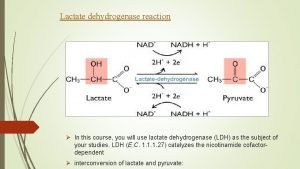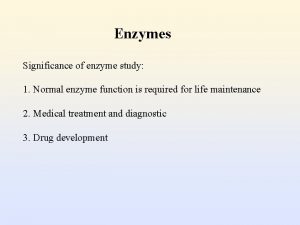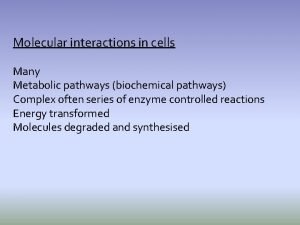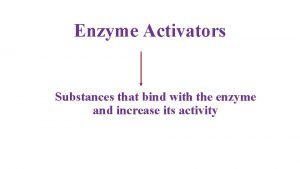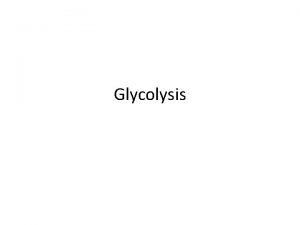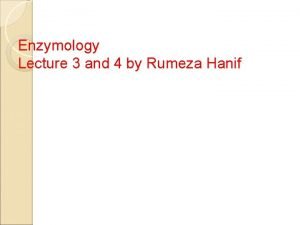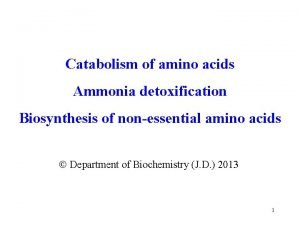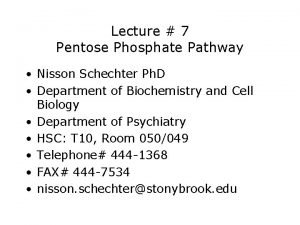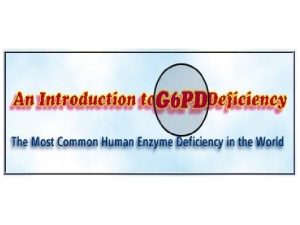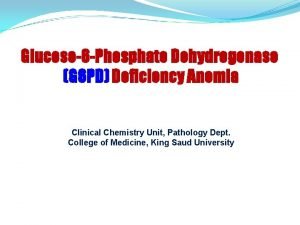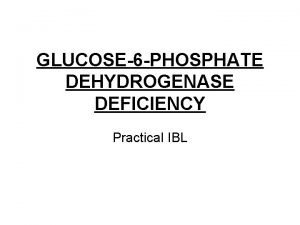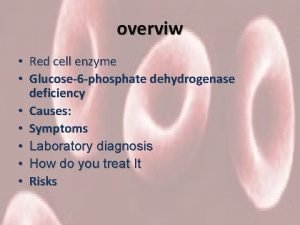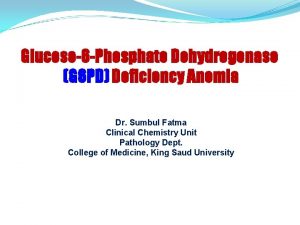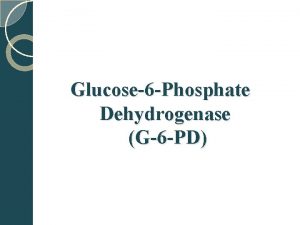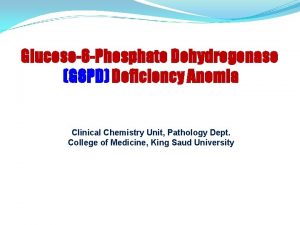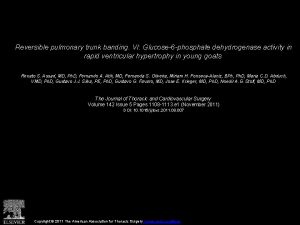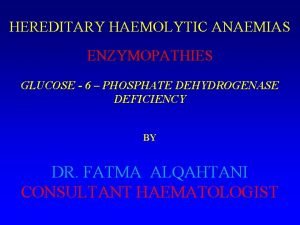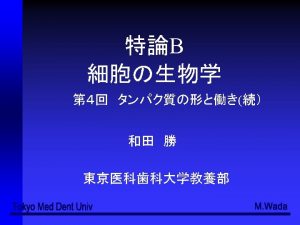Glucose6 Phosphate Dehydrogenase G 6 PD Glucose6 Phosphate













- Slides: 13

Glucose-6 -Phosphate Dehydrogenase (G 6 PD)

Glucose-6 -Phosphate Dehydrogenase (G 6 PD) deficiency l is the most common human enzyme deficiency in the world; it affects an estimated 400 million people. G 6 PD deficiency is also known as "favism, " since G 6 PD deficient individuals are also sometimes allergic to fava beans. G 6 PD deficiency is an allelic abnormality which is inherited in an X-linked recessive fashion

l When someone has G 6 PD deficiency, complications can arise; hemolytic anemia and prolonged neonatal jaundice are the two major pathologies associated with G 6 PD deficiency. Both of these conditions are directly related to the inability of specific cell types to regenerate reduced nicotinamide adenine dinucleotide phosphate (NADPH); this reaction is normally catalyzed by the G 6 PD enzyme.

Principle l l Glucose-6 -phosphate dehydrogenase (G 6 PDH, Dglucose-6 -phosphate) catalyzas the first step in the pentose phosphate shunt , oxidising glucose-6 phosphate (G-6 -P)to 6 -phosphogluconate(6 -PG) and reducing NADP to NADPH. G-6 -P + NADP+ G-6 PDH 6 -PG + NADPH + H+

l NADP is reduced by G-6 -PDH in the presence of G-6 -P. The rate of formation of NADPH is directly proportional to the G-6 -PDH activity and is measured spectrophotometrically as an increased in absorbance at 340 nm. Prodution of asecond molar equivalant of NADPH by erythrocyte 6 -phosphogluconate dehydrogenase (6 -PGDH) according to the reaction : l 6 -PG + NADP+ Ribulose-5 - phosphate + NADPH + H+ + CO 2

Specimen collection and storage l Whole blood collected with EDTA, heparine or acid citrate dextrose. Red cell G-6 -PDH is stable in whole blood for one week refrigrated (28ºc), but is unsteble in red cell hemolysates.

Procedure 1. prepare reaction mixture: • • • Add 0. 01 ml blood directly to vial containing G-6 -PDH assay solution and mix throughly to completely suspend erythrocytes, lat stand at room tempreture(18 -25ºc) for 5 -10 min. Add 2. 0 ml G-6 -PDH substrate solution directly to vial and mix gently by inverting several times. Transfer contents of vial to cuvet.

l l Place cuvet in constant tempreture cuvet compartment or water bath and incubate for approximatly 5 min to attain therma; equilibrium. Read and record absorbance (A 1) of test at 340 nm vs water or ptassium dichromate solution. This is initial A. (if using awater bath or incubator , return cuvet to it) Exactly 5 min later, again read and record (A 2), this is final A. To determine G-6 -PDH activity do the following calculation.

Calculation = ΔA per min X 4839 / Hb (g/dl) X TCF Where: l 100 = factor to convert activity to 100 ml l 3. 01 = total reaction volume (ml) l 0. 01 = sample volume (ml) l 6. 22 = mill molar absorptive of NADPH at 340 nm l Hb (g/dl) = hemoglobin concentration determined for each specimen l TCF = temperature correction factor (1 at 30ºc) l

Qualitative method in G-6 -DP determination: l Glucose -6 -phosphate dehydrogenase, present in the red blood cell hemoysate, act on glucose -6 phosphate and reduces NADP to NADPH which, with the help of PMS, reduces blue colored 2, 6 Dichlorophenol Indophenol into acolorless form. the rate of decolorization is proportional to the enzynme activity. The reaction can be represented as: l G-6 -phosphate +NADP 6 -phosphogluconic acid +NADPH

Procedure: Step 1: Preparation of red cell hemolysate: l Purified water : 2. 5 ml l Fresh blood : 0. 05 ml l Mix well and allow standing for 5 min at R. T.

l l Step 2: Assay of the enzyme: l Add 1 mi of the hemolysate (step 1) to the vial of solution 1 and mix gently. l Add immediately about 1 ml of reagent 3. l Seal the vial with aluminium foil and incubate in water bath at 37ºc. Observe: thetime taken for the color change from initial deep blue to reddish purple. Follow up to amax. Of 6 hours with 30 min intervals.

Results Normal: 30 -60 min. l G-6 -PD deficient (heterozygous males, homozygous female): 140 min-24 hr l G-6 -Pdcarriers (heterozygous females): 90 min-several hours.
 Lactate dehydrogenase
Lactate dehydrogenase Succinate dehydrogenase inhibitor malonate
Succinate dehydrogenase inhibitor malonate Succinate dehydrogenase inhibitor malonate
Succinate dehydrogenase inhibitor malonate Noncompetitive inhibitor
Noncompetitive inhibitor Pyruvate dehydrogenase
Pyruvate dehydrogenase Glucose to pyruvate cycle
Glucose to pyruvate cycle Succinate dehydrogenase inhibitor malonate
Succinate dehydrogenase inhibitor malonate Pyruvate dehydrogenase mechanism
Pyruvate dehydrogenase mechanism Uranium phosphate maroc
Uranium phosphate maroc Deamination of glutamine
Deamination of glutamine Luting
Luting Hmp pathway
Hmp pathway Fructose 1 phosphate glycolysis
Fructose 1 phosphate glycolysis Sglt1
Sglt1
